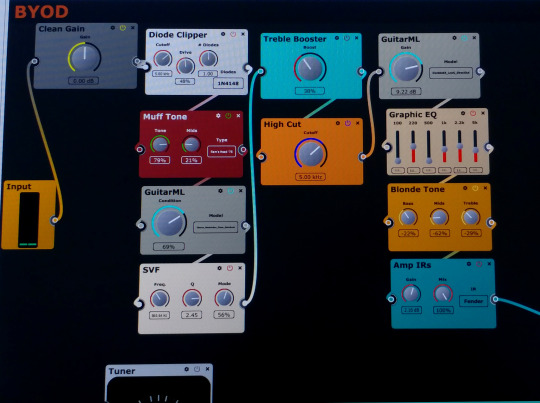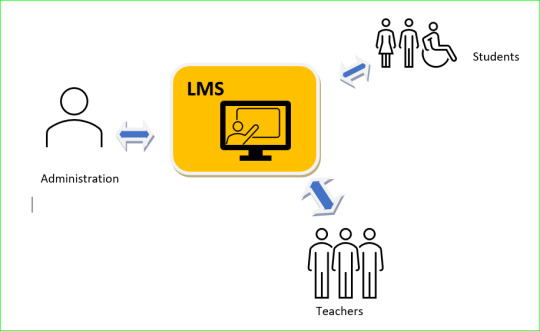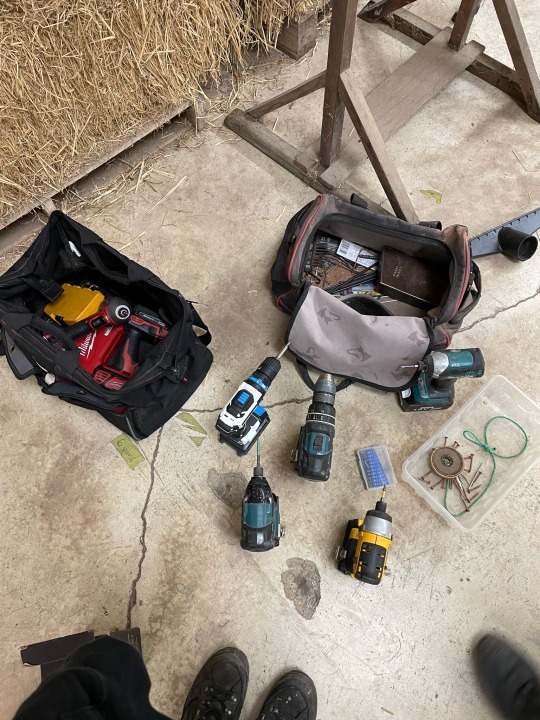#byod
Text
D&d Player Recruitment:
Looking for 2 new players for the group. We run long hours and have fun. Must be 18+, Fur Friendly, No Kink Shaming, Friendly (don't be a dick), Able to roll with the punches as a game plays, Team Player. Current group is chaotic, the DM is chaotic and doesn't hold back with descriptions or consequences and the game can be NSFW and graphic at times if/when it calls for it.
Game info: D&D 3.5e
Runs every Saturday noon to midnight
Uses discord for voice
Roll20 for gameboard
Myth-weavers for character sheets
The game will be set in a Victorian era with low magic (with dinosaurs). You wake up with no memory of your past and a foreboding feeling of what may be coming, and a guilt of what you may have done.
You'll be attempting to avoid the plot without knowing your past. Derail things, start a store, spend 5 hours helping an elderly man pick potatoes, but beware of the quest giver over at the inn. You will not know you class or abilities starting out. As you hit milestones you will level up and uncover more info on your abilities and class.
Summary - Avoid the plot, Amnesia, set in Victorian era low magic setting (with dinosaurs), Theme of Redemption
Varients - individual milestone and Cliche Variant to invoke cliches
DM will need character arch type (ie mage, caster, niche melee type) for the general character DM'll be making you so that DM can ensure you are playing something you'll like. You will not know your name at the start, other players will get randomly get assigned to pick races and names for other players. This will be uncovered as time goes on you start knowing not much more than you do now.
Message me if interested
Disclaimer:
There are two small children in the house, so noise levels may very dependent on the brand of chaos they choose to display.
#recruitment#dnd#d20#dungeons and dragons#geek#nerd#d5#3.5 edition#dragons#weekend#Saturdays#players#byod
6 notes
·
View notes
Text
India Foxtrot Echo - IndiGo’s foray into premiumization of services?
In September 2019, a sudden set of tweets (it was still twitter then) announced the launch of In-Flight entertainment in IndiGo. Most looked at the advertisements or press releases and took to social media excitedly. A look at the details and one realised it was a deal with Sonyliv where the airline had a partnership. A discounted seven day pricing allowed you to download anything (before the…

View On WordPress
0 notes
Text
Here are Five BYOD Principles to Consider from a Highly Respected Source

Navigating the complexities of Bring Your Own Device (BYOD) policies requires careful consideration of key principles. The Sedona Conference® Commentary on BYOD outlines five essential guidelines for organizations. From assessing business needs to safeguarding sensitive data, these principles underscore proactive management. Addressing BYOD concerns preemptively is crucial—check out the article below for insights into ensuring your organization's BYOD practices are both secure and compliant.
The entire article is here: https://forensicdiscovery.expert/here-are-five-byod-principles-to-consider-from-a-highly-respected-source/
#BYOD#DataSecurity#PolicyImplementation#SedonaConference#TechCompliance#digital forensics#forensic discovery#digital evidence#ediscovery
0 notes
Text
Why You Should Be Cautious of Agreeing to a BYOD Policy as an Employee
Bring Your Own Device (BYOD) policies have become increasingly common, offering employees the flexibility to use their personal devices for work-related tasks. However, while BYOD may seem convenient on the surface, it’s crucial for employees to understand the potential risks and implications before agreeing to such policies.
Here are several reasons why you should exercise caution before…

View On WordPress
#BYOD#Cybersecurity#dataprivacy#dataprotection#datasecurity#DeviceManagement#DigitalPrivacy#EmployeePrivacy#EmployeeRights#GDPRCompliance#ITSecurity#LegalCompliance#MobileDeviceManagement#PersonalDeviceUsage#PrivacyConcerns#RegulatoryCompliance#RemoteWork#TechPolicy#WorkFromAnywhere#WorkplaceTechnology
0 notes
Text
Secure Your Data on the Go: A Guide to Responsible Remote Wiping on Mobile Devices

#DataSecurityExpert#MobileDeviceManagement#BusinessContinuity#CybersecurityAwareness#ITProTip#EmployeeTechGuide#BYODPolicy#RemoteWorkSolutions#RemoteWipe#MobileSecurity#DataProtection#LostPhone#StolenPhone#TechTips#SecurityGuide#Cybersecurity#BYOD#BusinessTech
0 notes
Text
The idea of Bring Your Own Device (BYOD) has become increasingly prevalent in today's work environment. Employees are accessing company networks and carrying out work-related operations using their own smartphones, tablets, and computers.
0 notes
Text
WhatsApp, Slack, Teams, and other messaging platforms face constant security risks - Help Net Security
42% of businesses report employees with BYOD devices in business settings that use tools like WhatsApp have led to new security incidents, according to SafeGuard Cyber.
Messaging platforms like WhatsApp, Telegram, Slack, and Teams face constant threats, emphasizing the need for robust protection. 66% of threat indicators are found in transient messages associated with these cloud-based…

View On WordPress
0 notes
Text



Most every creative process begins with inspiration.
Sometimes the lack of which is, ironically, inspiration enough, lol.
Clever folks, new tech, and accessibility are wear the robes of the muse time and time again.
Thus enter ChowDSP and GuitarML.
I cannot stress enough the coolness-factor of ChowDSP’s BYOD and the GuitarML module/tone library!
Needless to say, the upcoming release is using these HEAVILY!
If you’re a musician, producer, engineer etc., please give a look and listen to what these cats have on offer.
And support if you can!
#guitar#recording#software#guitarml#chow#chowdsp#BYOD#bringyourowndistortion#guitarpedals#guitarfx#guitareffects#recordingstudio#newmusic#mathrock#bigmuff#new music#guitar pedals#guitar effects#bring your own distortion#recording studio
0 notes
Text
BYOD (Bring Your Own Device), CYOD (Choose Your Own Device), COBO (Corporate-Owned, Business-Only), and COSU (Corporate-Owned, Single-Use) are revolutionizing the way we work. 🌐
With BYOD and CYOD, you have the freedom to work on your preferred devices, making productivity a breeze. COBO ensures top-notch security for company-owned devices, while COSU optimizes single-use devices for specific tasks.
Say hello to a new era of flexibility, security, and efficiency! 🙌🔒💼
0 notes
Link
https://bit.ly/3QJOcmF - 🔐 Network Access Control (NAC) is a vital technology that controls access to network resources based on policies. It identifies, verifies, and assesses device compliance, granting access levels from full access to no access, with continuous monitoring for ongoing compliance. #CyberSecurity #NAC 📈 The Importance of NAC for Organizations: With growing endpoint usage and threat actors, automation provided by NAC reduces time, cost, and broadens potential attack surfaces. Features like Multi-Factor Authentication add an extra layer of security, making it essential for Zero Trust Security. #NetworkSecurity #ZeroTrust 🛠️ Types of NAC: Two essential forms - pre-admission and post-admission - provide a defense-in-depth strategy. Together, they keep threat actors from accessing network resources and discover unnoticed ones. #NetworkProtection 🎯 NAC Capabilities: These include Authentication, Role-Based Access Control, Device Profiling, Endpoint Security Assessment, Policy Enforcement, Quarantine, Remediation, and Integration with other solutions, adding a robust security layer. #NetworkManagement 🏆 Benefits of NAC: Enhancing security, saving costs through automation, streamlining user experience, and providing control, compliance, stronger authentication, are some of the key advantages. #CostSaving #Security 📱 Use Cases: NAC aids in managing BYOD, Network Access for Non-employees, IoT Devices, provides Visibility and Reporting, and helps in Incident Response, ensuring secure network handling across different scenarios. #IoTSecurity #BYOD 🧩 Choosing and Implementing a NAC Solution: Integrating NAC requires consideration of native integration with existing systems, all-in-one solutions, and planning. Steps like gathering information, managing identities, applying permissions, and regular updates are key. #NetworkIntegration In summary, Network Access Control (NAC) is pivotal in today's security landscape, offering protection, compliance, and enhanced user experience. Its implementation must align with the organization's structure and needs for optimal benefits.
#CyberSecurity#NAC#NetworkSecurity#ZeroTrust#NetworkProtection#NetworkManagement#CostSaving#Security#IoTSecurity#BYOD#NetworkIntegration#CyberSecurityAwareness#NetworkControl
0 notes
Text
0 notes
Text
Competence in Digital Pedagogy
Digital environments and tools of a training organization related to teacher work
Reflection on:
Learning managements systems?
Intranet content? Administration tools?
School equipment or BYOD? Security issues?
Communication platforms? Social media presence?
With advancement in technology, the educational systems has been changing from paper work to digital, and the work has been becoming…

View On WordPress
0 notes
Text
The convergence of ZTNA, mobile devices & identity management
New Post has been published on https://thedigitalinsider.com/the-convergence-of-ztna-mobile-devices-identity-management/
The convergence of ZTNA, mobile devices & identity management


Augusto Morales is a Technology Lead (Threat Solutions) at Check Point Software Technologies. He is based in Dallas, Texas, and has been working in cyber security since 2006. He got his PhD/Msc in Telematics System Engineering from the Technical University of Madrid, Spain and he is also Senior Member of the IEEE. Author of more than 15 research papers focused on mobile services. He holds professional certifications such as CISSP, CCSP and others.
In our increasingly interconnected digital domain, the convergence of Zero Trust Network Architecture (ZTNA), mobile devices and identity management has emerged as a critical focal point within cyber security. At-a-glance, these three elements may seem unrelated, but the rising prevalence of mobile devices as key tools for user and system authentication, often through multi-factor authentication, has blurred the lines between them.
In this interview with expert Augusto Morales, we delve into the security challenges and opportunities arising from this convergence. Don’t miss this!
1. How does the convergence of ZTNA, mobile devices and identity management impact the overall security posture of an organization?
At first glance, these three components—ZTNA, mobile devices, and identity management—seem to belong to different areas of cyber security. However, due to the increasing use of mobile devices as conduits to identify users and systems through methods like MFA, the lack of visibility between the interactions increases the attack surface for organizations.
For example, in a hypothetical scenario, a mobile device gets compromised because of a malicious application or an event, like smishing. Device compromise poses a risk to users’ identities. The core concept of ZTNA proposes that organizations should actively monitor deviations from baseline policies during sessions. In other words, if a mobile threat detection system exists, it should enforce controls to prevent these attacks. The current challenge has to do with the exploitation of Multi-Factor Authentication (MFA) mechanisms by malicious actors.
Another common example is seen among organizations that, in providing MFA, allow users to accept a push notification to confirm their identities. Cyber criminals take advantage of this by sending numerous MFA requests, a practice known as MFA bombing, to end-users until users accept and unintentionally authenticate the criminals.
MFA bombing, a.k.a. MFA fatigue, also presents other challenges. Some concepts within ZTNA address the situation, such as by inspecting behavioral and environmental attributes like geo-location. However, problems can arise when the human element is involved, and implementing ZTNA is not always possible due to privacy, technical, and regulatory constraints, such as BYOD, the impossibility of applying TLS inspection, and GDPR.
The paragraphs above describe examples of convergence and the challenges involved in achieving ZTNA. There are also initiatives aimed at reducing the cyber attack surface in these convergences. As a result, this topic will become something that organizations should address at the architectural level.
2. What are the implications of Bring Your Own Device (BYOD) policies in the context of ZTNA and identities for governments?
The popularity of BYOD is increasing; however, there is a limited ability to implement security controls and achieve ZTNA with a tolerance and risk level that’s acceptable for most companies. This challenge spans private and public organizations, as well as governments.
For instance, governments are accelerating the use of digital identities, particularly in the European Union. The basic idea is to use our mobile phones to prove who we are instead of relying on physical cards. This means that cyber criminals might start targeting mobile devices more often, as they are now crucial for verifying identities in government and private activities.
Imagine if cyber criminals were to steal a digital driver’s license; they could use it to impersonate individuals and carry out malicious actions, like taking out legitimate loans or even boarding planes.
Hackers could also steal identities to mislead authorities during cyber crime investigations. The same applies to data tampering. This situation could pose a very risky scenario for users, resembling what has been seen in financial institutions, where despite 40 years of research, industry consortiums, and billions of dollars invested, cloned cards, ATM hijackings, and recent abuses of AI to harvest financial data still persist.
The problem is that BYOD implementations haven’t received as much attention as they should have in terms of access control. Protecting private phones is complicated because organizations need to find a balance between keeping user information private and ensuring the protection of company data and identities. The entire industry is still figuring out whether it should prioritize security over convenience.
Based on our experience in many customer engagements, we have noticed difficulties in implementing cyber security concepts in the mobile world. For example, security controls like encrypted data-in-motion inspection pose problems, as certificate pinning is now widely implemented in applications. Therefore, it is imperative to understand how the mobile ecosystem works and how to implement reference architectures and guidelines provided by NIST.
Another related challenge is associated with the world of mobile software. It is essential to understand how and when to apply ZTNA principles to mobile software and its execution in non-trusted environments, such as the mobile OS itself or the network.
3. In the context of identity management, what are the best practices for ensuring strong authentication and authorization controls for mobile users accessing corporate resources under a zero trust model?
The recommendations that we consistently convey to our customers are closely tied to their business use cases and how to provide both protection and convenience. It is also crucial to assess the maturity, comprehension, and applicability of ZTNA and, lastly, the applicable mobile strategy (e.g., BYOD, CYOD, and COPE). Nevertheless, we can outline some generic best practices below:
A) Implement MFA company-wide for users and systems. This applies to all forms of Private Access, VPN, or SaaS applications.
B) Implement number or code matching.
C) Protect the enrollment process and use physical means to verify the legitimacy of the parties involved. For instance, a combination of voice, location, physical presence, and specific out-of-band knowledge can be utilized.
D) When possible, apply Mobile Threat Defense, or include self-protection features in applications that manage or interact with sensitive data at-rest and data in-motion.
E) Review default configurations and adapt them to meet the required identity governance policies. In the case of mobile phones, posture management helps continuously validate changes in software, such as CVEs and unsecured settings.
F) Identify anomalies in authorization and access control, particularly for SaaS applications.
4. How can organization balance user convenience and cyber security when implementing multi-factor authentication (MFA) for mobile users in a Zero Trust environment?
There are technical methods to protect mobile devices as the primary MFA mechanism. In some cases, maintaining this balance can be achieved through a thorough assessment of the attack surface. For instance, many companies use SMS as an MFA mechanism. In such cases, a Mobile Threat Defense solution like Harmony Mobile can inspect SMS messages and proactively identify potential malicious links. In other cases, it can notify cyber security staff if vulnerable applications are installed, enabling proactive conditional access enforcement.
To strike a balance between convenience and security while protecting MFA on mobile phones, we recommend three approaches:
Implement a Mobile Threat Defense (MTD) solution, such as Harmony Mobile. This control helps thwart attacks targeting MFA, even new techniques like “quishing” It monitors the network for potential Man-in-the-Middle attacks and deviations in the quality of the mobile OS that could compromise the integrity of the MFA workflow, such as with rooted or jailbroken phones. Additionally, MTD can identify malicious campaigns targeting high-profile individuals, which is particularly relevant in today’s environment where criminals employ AI-driven “vishing” attacks.
Utilize Mobile Application Management (MAM), where applications are managed via Mobile Device Management (MDM), and posture checks are continuously conducted by a Mobile Threat Defense (MTD) solution. In cases of violations, especially in BYOD scenarios, MTD can alert risky states to managed applications. As a result, these apps can cease providing access to MFA mechanisms like push notifications and password-less methods. A common example is the use of Microsoft Authenticator for MFA, known for its convenience. The MTD can block access to the service’s IP addresses and domains if continuous validation is necessary and a violation is detected. This aligns with one of the key tenets of ZTNA.
Incorporate a secure engine within the app providing the MFA mechanism. This is especially suitable for BYOD environments. Harmony App Protect is an example of this control. In this mode, the MFA independently monitors the network conditions and the mobile OS. It halts any authentication process in case of violations. This approach offers benefits in terms of privacy and user convenience as it doesn’t require additional software. The ZTNA policy decision point (PEP) and policy enforcement points (PEP) run locally on the phone based on pre-established policies to control the MFA workflow. However, a potential drawback of this method is its inflexibility regarding policy changes, such as IoC/IoA updates or containment policies, which may necessitate a new application update. Additionally, it could impact incident management plans and business continuity, requiring user interaction.
5. What are the potential risks and benefits of integrating mobile device biometrics (e.g., fingerprint or facial recognition) as part of the identity verification process within a ZTNA strategy?
The entire mobile ecosystem and society have demonstrated that biometrics are the de facto method for identity verification. When available, biometrics offer distinct advantages over traditional validation methods. However, it’s essential to understand that the triad of authentication factors – something you are, something you know, and something you have – should always be combined. Relying solely on biometrics can create a false sense of security. Studies, such as this one and this one, have shown that even real-time attacks on biometrics are possible. Therefore, it is crucial to consistently apply a defense-in-depth approach.
The ZTNA strategy can depend on continuous diagnostics and mitigation, as well as threat intelligence feeds to assess the likelihood of a mobile attack. Both Android and iOS have implemented hardware mechanisms to protect the Secure Enclave and biometric data from tampering and exfiltration. In the case of Android, due to OS fragmentation, addressing vulnerabilities at the hardware level is more challenging, which increases overall risk. There have been instances where vulnerabilities in system-on-chip components were exploited, raising the risk of privilege escalation. Such situations could compromise the identity verification process.
6. Is there anything else that you would like to share with the CyberTalk.org audience?
The industry and security practitioners should collaborate to address the security perception offered by certain actors. There is no single silver bullet provided by a “mobile ZTNA product” that can solve identity management. A ZTNA strategy will always depend on how well mobile data flows are understood and how much visibility is maintained over the entire mobile ecosystem, which grows in complexity each day. This ecosystem encompasses applications, APIs, backends, mobile OS, and, of course, the human element. It may seem overwhelming, but a good starting point is to apply proven mobile security practices to common use cases.
#access management#ai#android#APIs#app#applications#approach#apps#architecture#Augusto Morales#authentication#biometric#biometrics#Business#business continuity#BYOD#Certifications#challenge#Check Point#Check Point Software#CISSP#code#collaborate#Companies#comprehension#course#crime#cyber#cyber attack#cyber crime
0 notes
Text
BYOD Classrooms
The School of the Future

Introduction:
Technology is becoming increasingly prevalent in our daily lives, with new trends emerging in 2023 that are only expected to grow in the years to come. Schools and other educational institutions have been particularly impacted by this shift, as classrooms are now more interactive and enjoyable thanks to the incorporation of new technologies. It’s exciting to see how technology is transforming the way we learn and interact with one another.
Implementing a “bring your own device” (BYOD) policy is an excellent way to make learning more personalised and provide students with an opportunity to use technology that is familiar to them. With BYOD, students can access online resources, collaborate with peers, and personalise their learning experience in ways that weren’t possible before. Additionally, BYOD can help reduce the financial burden of purchasing individual devices for each student, as well as save time for educators who don’t need to manage multiple devices. By leveraging the power of BYOD, educators can create a more personalised learning environment that allows students to take control of their educational experience.
Discover a Technology Toolbox:
The modern virtual toolbox for an effective teacher includes the best apps and online programs for efficient instruction. We have found some of the most popular options that encourage collaboration among students, teachers, and family members, as well as those that give students more control of the content they learn. Google’s suite of tools is an amazing way to collaborate with others, both near and far. Through Google Drive, anyone can access and share content instantly with others. It’s great that the original file creator can assign permissions to other collaborators and view any changes that are made in real-time. Having this level of collaboration capability makes it much easier for teachers and students to work together on projects, no matter where they are located.
1 note
·
View note
Text
Concentration on something involves giving all your attention to one thing. But they consider your kids they can't concentrate on one thing at a time. So they need to improve your kids' focus and memory power by giving them concentration exercises for studentsthat are given by the brain training institute. In this training, kids are to be trained by professional trainers to get them fast learners and score good marks in all the subjects. For important subjects, the maths tuition in Chennai gives the best training to develop the skill in kids.
#lrnchat#edchat#blendchat#mlearning#elearning#ipadchat#pbl/#pblchat#passiondriven#ntchat#gbl#edtech#ukedchat#web20#flipclass#BYOD#iPaded#EdApps#k12#cpchat#highered#21stedchat#whatischool#earlyed#elemchat#middleschool#highschool#commoncore#cchat#edreformtribe
0 notes
